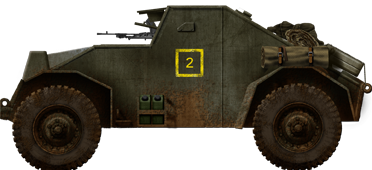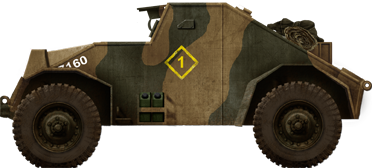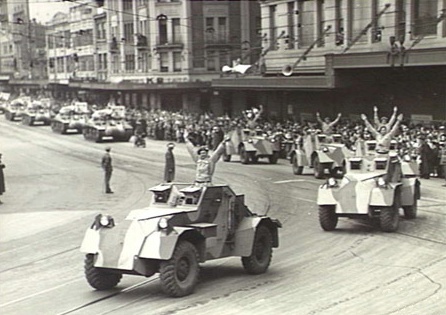The Australian light scout car
Often confounded with the British Daimler Scout Car, also known as the "Dingo", this little vehicle was a wartime national procurement, named after the local species of wild fox. It was born from a specification issued by the Army staff in early 1941, to cover immediate local needs. It was to be built using national resources (like the ABP3 plates), knowing that Great Britain was unable to supply any armored vehicles. In this context, the existing automotive and industrial facilities were mobilized to produce a small vehicle, based on a modified Ford commercial 30-cwt truck with a 134.5 inch wheelbase, mixed with a 4x4 wheel drive kit from Marmon-Herrington and covered with Victorian Railways ABP3 armored plates. Mass production was launched in early 1942. When it ended in 1943 (when large supplies of British and US built vehicles were available), 245 vehicles had been delivered.Design
The chassis is that of a Ford lorry, shortened from 340 to 297 cm, fitted with a Marmon-Herrington all-wheel drive kit. A leaf spring suspension system was installed, and the wheels were two piece rims. The tires were of the "run-flat" type. The 85 horsepower Ford V8 engine was key started, backed by an emergency external crank. The main gearbox had four forward and one reverse gear, joined to an auxiliary transfer box, which supplied constant four wheel drive with an automatic compensator.The entire upper body was all-welded and constructed from ABP3 (Australian Bullet Proof 3) armor plates, as specified by the army. The crew compartment comprised two seats, for the driver and the commander. The latter could mount and operate the Bren machine gun, which was protruding from a central opening hatch. Both bulletproof windows were protected by armored shutters. The fuel tanks were placed at the rear, protected by bulkheads. The crew accessed the vehicle through a side door on the left of the vehicle, equipped with an internal locking handle and pierced by a vision slit with armored cover, which could be opened/closed from the inside.
There was also a sliding panel roof, for observation and ventilation, which could be locked. An observation shutter in the rear of the crew compartment was also present, on a quadrant. The adjustable seats consisted of metal tubes covered with leatherette backs and padded seats. Equipment comprised a Wireless set No. 19 Mk II radio and additional ammo racks for the Bren, a first aid kit, water and oil cans.
Service
These Dingos were shipped to serve with the 1st Australian Armoured Division from mid 1942 in North Africa, but it appeared quite quickly that their off-road capabilities were less than satisfactory. Production was halted back home, and the vehicles already delivered were used for training. Australian scout units were eventually equipped with Canadian Lynx armored cars.Links about the Dingo
The Dingo on WikipediaOn the Australian War Memorial page
Walkaround by Michael Grieve
Existing vehicles by the Schadocks
| Dingo specifications | |
| Dimensions | 4.6 x 2.1 x 1.9 m (15 x 6.8 x 6.2 ft) |
| Total weight, battle ready | 4.5 tons (9000 lbs) |
| Crew | 2 (driver, commander) |
| Propulsion | Ford V8 80-95 hp, 21 hp/t |
| Suspensions | Leaf springs, 4x4 drive |
| Maximum speed | 90 km/h (55 mph) |
| Armament (optional) | Bren LMG .303 (7.7 mm), 2500 rounds |
| Armor | From 4 to 6 mm (0.2-0.28 in) |
| Total production | 245 |

Green factory livery, 1942.

Camouflaged Dingo, 1943
Australian Cruiser gallery
A Dingo Scout Car at the Australian War Memorial, photo taken on the 10th of March 2007.

Parade in the streets of Sydney in December 1942

WW2 Tanks




























WW2 tanks posters

All Tiger tanks liveries.

Panther liveries and variants

WW2 Armour - All tanks











Tanks aces and single tanks series

Find more there

Museums, Movies, Books & Games
The Tanks and Armor in pop culture
Tanks and armored vehicles in general are only really grasped when seen first person: The mass, the scale, it's all there. Explore also the way tanks were covered in the movie industry, in books and in video games.Movies:
Best tanks movie on warhistoryonline.com
On imdb.com
On bestsimilar.com/
miltours.com
liveabout.com/
watchmojo.com
Video Games:
pcgamesn.com
historyhit.com
levvvel.com
vg247.com/best-tank-games
mmobomb.com/
alienwarearena.com

